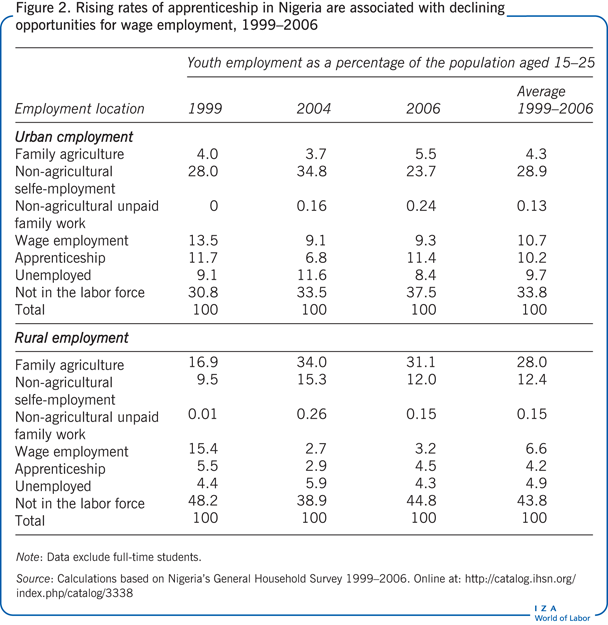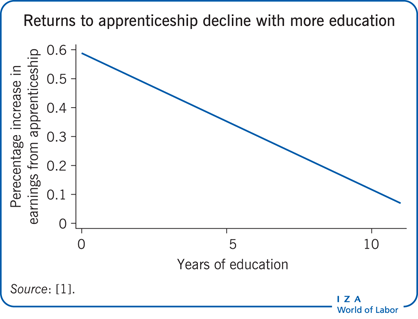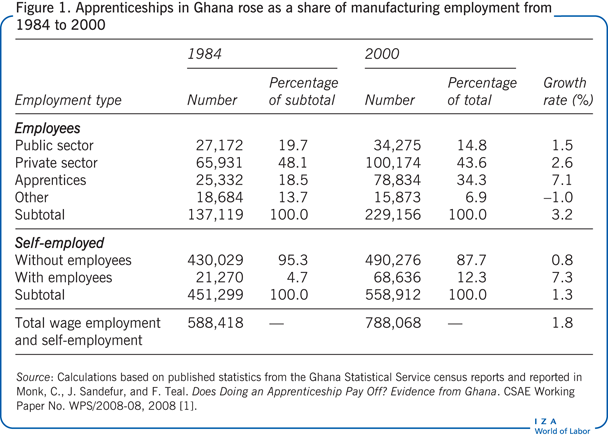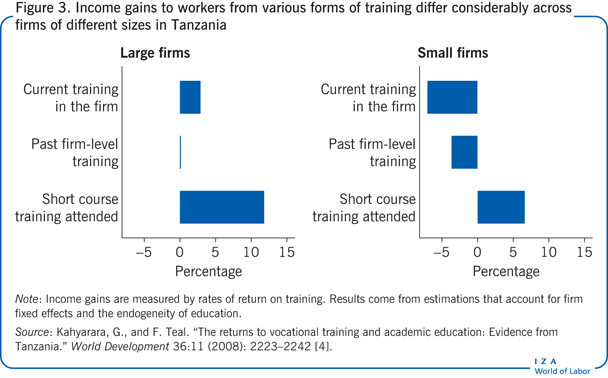Elevator pitch
Apprenticeships are the most common form of non-academic training in sub-Saharan Africa. Most apprenticeships are provided by the private sector, for a fee, and lead to self-employment rather than to wage jobs. Where the effects have been measured, they show that earnings are not higher, on average, for people who did an apprenticeship than for those who did not. This presents a conundrum. Why would people pay for apprenticeship training that does not benefit them? Research reveals that apprenticeships do benefit some people more than others. Especially striking is that the returns to apprenticeships can fall with the level of education.
Key findings
Pros
Household surveys in sub-Saharan Africa show that traditional apprenticeship is by far the most important form of training in Africa’s informal sector.
Apprenticeships transmit traditional skills.
Apprenticeships have expanded with the growth of the informal sector.
Research on apprenticeships in Ghana shows a significant increase in earnings for the self-employed but no effect for wage employees.
Research on Uganda shows an increased demand for training once credit constraints are relaxed, along with an increase in earnings.
Cons
Apprenticeships do not lead to wage jobs.
In Nigeria, wage opportunities for youth declined over 1999–2006, making apprenticeship a more attractive option.
The growth in apprenticeships is linked to self-employment, where returns are dependent on access to physical capital, which is not readily available.
Returns to training can be low relative to returns from higher levels of academic education.
Returns to training differ considerably, and averages are misleading.
Author's main message
For a majority of the population in sub-Saharan Africa, academic and financial constraints are major blocks to formal education, which focuses on academic rather than technical training. Thus, for many people apprenticeship is the only route to employment. However, because apprenticeships impart mainly traditional skills, not new skills needed for successful innovation, they lead almost exclusively to self-employment not to wage jobs, where returns are dependent on access to physical capital. Rather than expand apprenticeships, policy needs to focus on the failure to create more high-productivity wage jobs.
Motivation
Apprentices play a key role in Wagner’s opera The Mastersingers of Nuremburg. Their task is to learn the rules of the guild. The problem with this apprenticeship model is that while it can transfer traditional skills across generations, it does not provide a basis for innovation. Indeed, in the opera it is an outsider, untutored in the ways of the guild, who carries off the prize by challenging the rules. Whether modern-day apprenticeships simply transfer old skills or support innovation by imparting new ones is an area of active policy discussion in both developed and developing countries. Apprenticeships cover many forms of training and operate under a wide array of institutional arrangements in economies with very different economic structures. This review focuses on how apprenticeships operate in sub-Saharan Africa, where most apprenticeships are in the private informal sector, and where manufacturing is still a very small part of the economy, except in South Africa. Further, formal education systems typically concentrate on providing an academic rather than a technical education. Because of these features, the way that apprenticeships fit into the overall acquisition of human capital differs in sub-Saharan Africa than in developed countries and in other developing countries. Unless policy can more successfully create higher paying wage jobs, expanding apprenticeships will not, for most people, result in high incomes for the newly trained.
Discussion of pros and cons
Education systems in sub-Saharan Africa shape the choice of apprenticeships
Both the path into apprenticeships and the path out may differ fundamentally across education and apprenticeship systems. Such different paths matter when it comes to understanding who does an apprenticeship and how much they benefit.
A key difference across education systems, which can differ in many ways, is how they link academic and vocational streams. The educational options open to students in large part determine which young people enter apprenticeship systems and why. In some countries, it is possible to move between academic and vocational education streams, while in others the streams are quite separate. For example, educational systems in Israel and Thailand allow students who have chosen vocational education access to higher education [2], [3]. In both countries, vocational education has as high a return as—and sometimes higher than—an academic education. Within much of sub-Saharan Africa, public educational systems stress academic training almost exclusively. Tanzania shifted the focus of its education system from vocational to academic instruction in the 1990s, influenced in part by arguments from influential aid donors [4]. In Kenya, an attempt in the 1980s to shift the education system to a more vocational focus failed.
Thus, in contrast to educational systems with parallel academic and vocational educational streams, in sub-Saharan countries vocational training through apprenticeships may be an enforced choice for young people when further progress in the formal academic educational system is blocked, either by financial constraints or by their academic performance. Further, most apprenticeships are not a route into formal wage employment in large enterprises or public sector enterprises. Rather, traditional apprenticeships are a route to self-employment or employment in small, informal sector jobs [5].
A traditional apprenticeship is the leading form of training for the informal sector
Apprenticeship training has a long history in many sub-Saharan countries, and it continues to expand. Household surveys show that traditional apprenticeship is by far the most important form of training in the informal sector. In six countries for which comparable data are available (Côte d’Ivoire, Ghana, Rwanda, Sierra Leone, Tanzania, and Uganda), on average 20% of young adults aged 24–35 have had apprentice experience, although the share varies across countries, from 6% in Uganda to 35% in Ghana [6]. Such apprenticeship training occurs exclusively in the private sector, where the owner of an informal enterprise takes on apprentices, usually for a fee, and provides training in traditional skills over a period of three or more years. Within the manufacturing sector, these skills are mainly in carpentry, sewing, and metal work. Particularly in West Africa, traditional apprenticeships are a far more important source of training than formal training and vocational education systems [5], [6].
The importance of traditional apprenticeship training in Ghana and its expansion are shown in Figure 1, which draws on census data for the manufacturing sector. In 1984, apprentices made up 18.5% of workers in Ghana who were classified in manufacturing wage employment, which includes both formal and informal enterprises. While some apprentices are paid a small amount for food, most are not paid at all. By 2000, this share had nearly doubled to 34.3%. The growth rate of apprenticeships was similar to the growth rate of self-employment in firms with employees. In addition, within self-employment, there was a significant shift from one-person firms (“without employees”) to self-employment with employees. The pattern revealed by the data is consistent with former apprentices establishing similar types of enterprises to the ones in which they trained and then employing apprentices of their own. It is clear that apprenticeship is not only the most important source of training but also the most rapidly rising source of employment within the manufacturing sector over this period. In Kenya, too, the informal sector, where apprenticeship training predominates, continues to grow [7].
Nigeria is now the largest economy in sub-Saharan Africa, by population and economic size. The employment opportunities for its young people are a central topic in policy debates in that country. Figure 2 shows that apprenticeships are an important occupational outcome for young people in Nigeria, where almost all apprenticeships are in the private traditional small-scale sector [8].

Comparative studies of apprenticeship in sub-Saharan Africa find it to be most common in West Africa. This may be due to the higher incomes and greater degree of urbanization in the region, creating demand for manufactures that small-scale enterprises are well-equipped to meet. As in Ghana, most such enterprises in Nigeria will be run by people who have graduated from apprenticeships and who themselves employ apprentices. With wage opportunities declining rapidly for the young in Nigeria and with continuing growth in demand within the informal sector, apprenticeship will become increasingly attractive. The high rates of joblessness in Nigeria may be due to the low returns for many in the informal sector (those with other means of support do not wish to enter the sector) and to the existence of credit constraints that prevent young adults from being able to pay the costs of undertaking an apprenticeship (see below).
How valuable are apprenticeships and training?
Within sub-Saharan Africa, quantitative information on apprenticeships is most abundant for Ghana, where informal apprenticeship is the most important source of training in the urban economy [1], [9]. Research using data from the Ghana Living Standards Survey has found no significant effect of apprenticeships on earnings for employees in urban areas [9]. Research using more detailed data from the Ghana Urban Panel Survey found that urban workers who had done an apprenticeship earned less than those who had not [1]. Conducting the analysis again after substituting Ghana Living Standards Survey data for 1991/92, 1998/99, and 2005/06 yield the same significant and negative result. When controls for education and age are included, estimates for apprenticeships, using either data source, remain negative, but they are no longer significant. This suggests that part of the reason for the lower earnings for those who have done an apprenticeship than for those who have not is the low levels of human capital, broadly defined, among apprentices.
However, that even allowing for these differences does not yield a positive return from undertaking an apprenticeship suggests the presence of a selection issue, in that only certain types of young people undertake an apprenticeship. Indeed, apprenticeship training is expensive, especially relative to the incomes of those who are paying for it. Accounting for the fact that people who choose apprenticeships may differ in important unobservable ways from those who do not, estimations based on Living Standards Survey data show a significant increase in earnings due to apprenticeships for the self-employed (17% higher) but no effect for wage employees [9].
By far the most important observable factor affecting the return to apprenticeship is the level of formal education. Among people who are currently employed, having an apprenticeship increases earnings by roughly 50% for those with no formal education. The average increase over the entire sample is closer to 10%. The most important point to draw from these estimates is that returns differ considerably across groups and decline as education rises. Those who enter apprenticeship with no formal education may well be atypically able while those who enter it with a junior high school education may be of lower ability. This unobserved ability would explain why apprenticeship pays off most for those with no formal education [1].
The finding that the returns to apprenticeship depend in part on the level of education points to another aspect of the selection issue that is important in understanding who undertakes an apprenticeship. The evidence for sub-Saharan Africa is overwhelming that these returns are highly convex, which means that they increase with the level of education. If returns are higher at higher levels of education, some people may choose an apprenticeship if their academic path is blocked by lack of ability or inadequate finances. In such circumstances, differences in the returns across different types of education and training are to be expected.
Such diversity is found in a study of Tanzania using data on in-firm training in manufacturing firms (Figure 3) [4]. In principle, in-firm training would appear to have the same function as an apprenticeship. However, in more formal firms (firms above a minimum size), such training is tailored to the specific requirements of the job and the firm and differs from the more general skill acquisition common to the traditional apprenticeship system in small firms. Thus, the income gains to workers from various forms of training differ considerably across firms of different sizes as shown in Figure 3. Only in large firms are there positive returns to current or past training. There is some return to a short course in all types of firm, but it is much greater for larger firms.
Another study investigates the return to training for Kenya and Zambia, also using firm data. It identifies an average effect from training which can be substantial for larger firms [10]. These results are consistent with the range of outcomes found for Tanzania, implying that returns to such training are quite varied based on firm size.
With declining wage opportunities in Nigeria, the opportunity costs of apprenticeship are decreasing
Rising rates of apprenticeship are associated with declining prospects for wage employment in Nigeria. Over the period 1999–2006, wage employment for young urban Nigerians (ages 15–25) as a share of the urban population fell by almost half, from 14% to 9%, while non-agricultural self-employment fell from 28% to 24% (see Figure 2). At the same time, there were increases in the proportions of the population in family agriculture and out of the labor force. In rural areas, wage employment practically disappeared, declining from 15% to 3% of the population, and employment in family agriculture nearly doubled.
Particularly striking is the large proportion of Nigerian youth who are outside the labor force—not so much because they do not want to work as because they know that jobs are unavailable. The scarcity of jobs is starkly shown in Figure 2. In 2006, only 33% of urban youth ages 15–25 who were not in full-time education were in wage employment or non-agricultural self-employment—and only 15.2% of rural youth.
In these circumstances, the opportunity cost of an apprenticeship in terms of forgone earnings is likely to be very small for most young Nigerians. If that is the case, then the question is not why apprenticeships have expanded but why they have not expanded more rapidly. This issue is discussed next.
Training and credit constraints
So, why have apprenticeship programs not expanded more, given their low cost and the high returns for some participants, along with the declining income opportunities for young people in much of sub-Saharan Africa? This question is implicitly answered in a study for Uganda that investigates the effects of a grant for young people that, in effect, relaxes any credit constraint to training [11]. Under the Youth Opportunities Program in northern Uganda, designed to help poor and unemployed adults become self-employed artisans, the government invited young adults to form groups and prepare proposals for how they would use a grant for training in an independent trade and starting a business. Funding was randomly assigned among 535 screened, eligible applicant groups. Successful proposals received one-time unsupervised grants worth $7,500 on average—about $382 per group member, which was roughly their average annual income. What is unusual about this experimental study is that those who obtained a grant, which was a substantial amount of money, were free to choose what to do with it. As the experimental design was carefully carried out, there is some assurance that the study properly identified the causal effect of reducing credit constraints facing young people.
The amount of vocational training undertaken by grant recipients increased sevenfold, from 49 hours to 340.5 hours, and recipients also invested substantially in physical capital. As a result of these investments, grant recipients had incremental cash earnings of $10.60 a month after four years from receiving the grant compared with earnings of $28 among members of the control group. Clearly, while a small amount of income in absolute terms, $10.60 more a month is a substantial increase relative to the low level of incomes. Further, while the nearly 300-hour increment in vocational hours might seem large, it is equivalent to just seven to eight weeks of full-time work, while a traditional apprenticeship can last three to five years. One interpretation of these findings is that the skills required can be learned quickly and that the length of a traditional apprenticeship is designed to accommodate the need for firms to make a profit from the output produced by the trainees.
Limitations and gaps
Much more is known about the nature of traditional apprenticeships, such as how they are organized and the types of enterprises that employ apprentices, than about their costs or their benefits. Only for Ghana is the information available that is needed to compare the earnings of those with and those without apprenticeships, a basic requirement for understanding the effects of apprenticeship training and the rapid expansion that appears to be occurring. The selectivity into apprenticeship, as the data for Ghana clearly shows, suggests a need to understand which policies affect the processes that drive young adults to choose the apprenticeship option.
The study of the grant program in Uganda is unusual as the grant can be used however the grantee wishes. This approach of bestowing unconditional grants contrasts with the normal approach of seeking to assess whether a grant given for a specific activity has the desired effect, as with ongoing studies of apprenticeship training in Kenya and Malawi, which implicitly seek to assess the effect of subsidizing training [12], [13]. Although the studies are at too early a stage to show longer-term results, the Malawi study has concluded that training has improved the skills and self-reported well-being of participants, especially men, despite having no positive labor market outcomes in the short term.
The potential importance of selectivity in affecting returns to apprenticeship, as with any form of investment in human capital, has motivated the design of randomized controlled trials. Proponents of this approach argue that without this kind of design, which solves the selection issue by randomly allocating people to the treatment group, any true causal effect from apprenticeship cannot be identified. However, as with any data, there are drawbacks as well as advantages to this approach. Such an approach may fill a gap in the knowledge about the effect of a modest expansion of apprenticeships in Kenya or Malawi. However, unless there is an understanding of the factors limiting access to apprenticeship, it is impossible to know whether a particular result will be replicable elsewhere. Another concern is that any attempt to scale up the program will lead to changes in prices, which may alter the underlying cost–benefit calculus.
The Ugandan study is an advance as it identifies possible underlying constraints that affect the outcome, the most plausible being that the relaxation of credit constraints leads to investments in both training and physical capital. However, that only gets one so far. Without survey data that can inform policymakers of the relative returns across activities and provide some understanding of the factors influencing choices across the range of educational and training options, it is impossible to use experimental data to forecast outcomes of policy changes on anything other than a micro scale.
Recent work has incorporated experimental data into a more general framework that models choices across policy options. While this work has only just begun, it does offer the possibility of addressing the selection issues that are central to any assessment of the value of apprenticeship in sub-Saharan Africa.
A further serious gap in knowledge about the effects of any increase in training concerns the reasons underlying the decline in wage opportunities in larger firms. As documented above, wage opportunities for youth in Nigeria have declined precipitously over the period 1999–2006. Unless the reasons for this decline are better understood, any increase in training may lead to more young people entering a sector with low and decreasing returns relative to what would be possible with higher productivity wage jobs. As poor as our information of the supply side of the market is, that on the demand side is even weaker.
Summary and policy advice
Empirical findings from Ghana show that people with lower levels of education benefit more from apprenticeship than those with more education. This supports the idea that apprenticeship is not the preferred choice of those who have completed a junior secondary education (the educational level of most apprentices). In addition, credit constraints may play a leading role when it comes to deciding how much to invest in apprenticeship training. Findings from Uganda indicate that relaxing credit constraints leads to investments that enable young people to enter a more profitable form of self-employment.
Both of these aspects of selection (based on education and on credit constraints) have important implications for policy. Any expansion of secondary education, as is occurring in many sub-Saharan African countries, will likely reduce the numbers of young people wishing to enter apprenticeships. Similarly, the expectation from any general relaxation of credit constraints would be for an expansion in self-employment.
The policy problem is clear. The Ugandan study concludes that the economic case for public investment in employment is strong. However, if the study’s interpretation of results is correct—that relaxing credit constraints leads to large income gains—a more general question concerns which credit constraints should be relaxed. For example, access to human capital, including schooling, may be viewed as credit constrained. Put more directly: Is money spent on youth opportunity programs better spent on enabling more children to go to better quality schools?
The crux of the issue here is the low quality of most public education. There is growing evidence that parents in sub-Saharan Africa are willing to pay for low-cost private schooling because it is perceived to be of much higher quality than public schooling. Thus, if the problem is credit constraints, the policy question is whether expanding low-cost private schooling would lead to higher returns and have a greater impact on poverty than expanding the present apprenticeship system. Whatever the answer, the follow-up question is about the best way to relax these credit constraints.
Earnings in self-employment are low relative to the earnings in wage employment achieved by people with a secondary school education or higher. Thus, it seems likely that a general relaxation of credit constraints would lead to an increase not in apprenticeships but in demand for secondary and higher education. At present, the private sector supplies most of the apprenticeships and the public sector most of the education.
And that brings us back to Wagner’s opera. The Mastersingers of Nuremburg lacks an extensive treatment of the forgone opportunities of apprenticeships. In medieval Europe, those returns can be assumed to be low. According to the analyses discussed here, apprenticeships in sub-Saharan Africa are an outcome dictated in substantial part by the inability of young people to proceed further through the formal education system. The private sector has supplied opportunities to learn that the public sector-dominated education system has failed to do. Apprenticeship in sub-Saharan Africa is much closer to the medieval apprenticeship in Wagner’s opera than to the skill-enhancing traineeships in BMW auto plants in Germany, which serve as an extension of the formal education system rather than an alternative and lead to wage jobs rather than to small-scale self-employment.
Acknowledgments
The author thanks an anonymous referee and the IZA World of Labor editors for many helpful suggestions on earlier drafts. This paper draws heavily on work conducted with Courtney Monk and Justin Sandefur [1].
Competing interests
The IZA World of Labor project is committed to the IZA Guiding Principles of Research Integrity. The author declares to have observed these principles.
© Francis Teal


